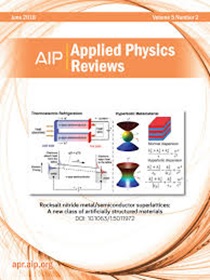Large interfacial Dzyaloshinskii–Moriya interaction of epitaxial perovskite La0.7Sr0.3MnO3 films
IF 11.6
1区 物理与天体物理
Q1 PHYSICS, APPLIED
引用次数: 0
Abstract
The Dzyaloshinskii–Moriya interaction (DMI) is pivotal in stabilizing topological spin textures, a critical aspect of the rapidly advancing field of oxide-based spintronics. While skyrmions and the topological Hall effect have been widely studied in oxide films, experimental verification of interfacial DMI and its underlying mechanisms in oxide interfaces has remained largely unexplored. In this study, we report a significantly large interfacial DMI in La0.7Sr0.3MnO3 (LSMO) films grown on NdGaO3 substrates, with a DMI coefficient of 1.96 pJ/m—one to two orders of magnitude higher than previously observed in oxide systems. Our experiments, coupled with first-principles calculations, reveal that enhanced spin–orbit coupling at the LSMO/NdGaO3 interface, driven by a synergy between the 6s electrons of Nd and the 4f electrons, is the key to this large DMI. This breakthrough opens new avenues for controlling chiral spintronics in oxide-based materials, laying the groundwork for next-generation spintronic and magnonic devices.外延钙钛矿La0.7Sr0.3MnO3薄膜的大界面Dzyaloshinskii-Moriya相互作用
Dzyaloshinskii-Moriya相互作用(DMI)是稳定拓扑自旋织构的关键,是快速发展的氧化物基自旋电子学领域的一个关键方面。虽然skyrmions和拓扑霍尔效应已经在氧化膜中得到了广泛的研究,但界面DMI的实验验证及其在氧化膜中的潜在机制仍未得到很大程度的探索。在本研究中,我们报道了生长在NdGaO3衬底上的La0.7Sr0.3MnO3 (LSMO)薄膜的界面DMI显著增大,其DMI系数为1.96 pJ/m,比之前在氧化物体系中观察到的DMI系数高1到2个数量级。我们的实验,结合第一线原理计算,揭示了由Nd的6s电子和4f电子之间的协同作用驱动的LSMO/NdGaO3界面上增强的自旋轨道耦合是这种大DMI的关键。这一突破为在氧化物基材料中控制手性自旋电子学开辟了新的途径,为下一代自旋电子和磁子器件奠定了基础。
本文章由计算机程序翻译,如有差异,请以英文原文为准。
求助全文
约1分钟内获得全文
求助全文
来源期刊

Applied physics reviews
PHYSICS, APPLIED-
CiteScore
22.50
自引率
2.00%
发文量
113
审稿时长
2 months
期刊介绍:
Applied Physics Reviews (APR) is a journal featuring articles on critical topics in experimental or theoretical research in applied physics and applications of physics to other scientific and engineering branches. The publication includes two main types of articles:
Original Research: These articles report on high-quality, novel research studies that are of significant interest to the applied physics community.
Reviews: Review articles in APR can either be authoritative and comprehensive assessments of established areas of applied physics or short, timely reviews of recent advances in established fields or emerging areas of applied physics.
 求助内容:
求助内容: 应助结果提醒方式:
应助结果提醒方式:


